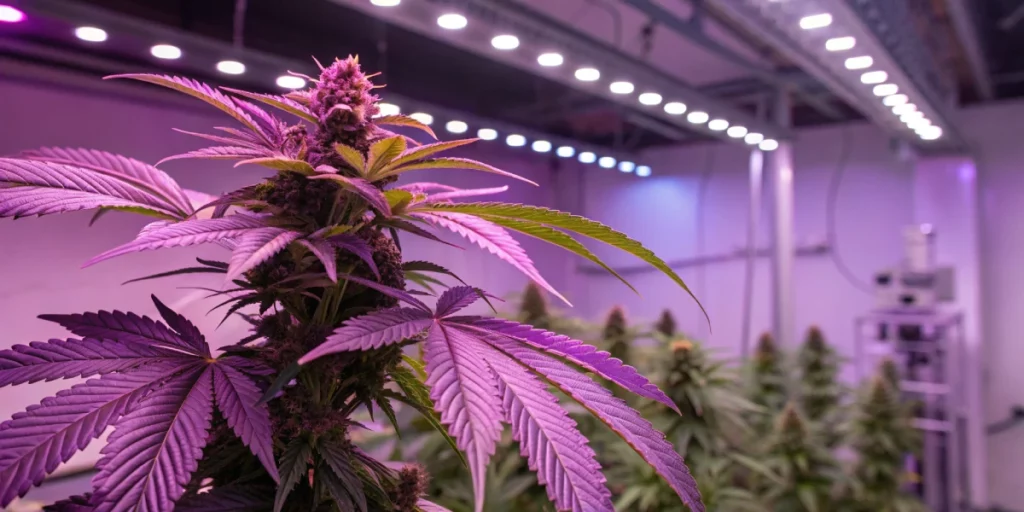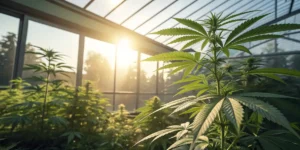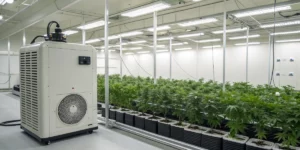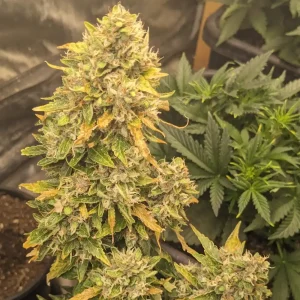Genetics and Pigmentation in Purple Cannabis: Why is some weed purple?
Role of Anthocyanins in Color Change
Anthocyanins are natural pigments that form in cannabis when conditions trigger their production. These pigments mix with chlorophyll and change the plant’s color, leading many to ask, why is some weed purple? The production of anthocyanins is influenced by temperature, light, and stress. When conditions cool, the plant produces more anthocyanins, resulting in that eye-catching purple hue. This process is natural and varies between strains.
The amount of anthocyanin produced depends on the plant’s genetics. Specific strains have been bred to display more vivid colors, making them favorites among growers seeking a unique look. The interaction between these pigments and the plant’s natural compounds explains why is some weed purple and why some varieties are more prone to this change.
Genetic Factors Influencing the Purple Hue
Genetics play a significant role in determining why is some weed purple. Some cannabis strains inherently carry the genetic markers for higher anthocyanin production. This means that even under similar conditions, one strain may show more purple coloration than another. Breeders have selected plants that naturally exhibit these traits, so the question of why is some weed purple becomes partly a matter of lineage.
These genetic factors ensure that certain plants will develop a purple hue, particularly when environmental conditions support pigment production. The interplay of genetics and environmental stressors is key. Growers appreciate these strains for their visual appeal and ease of cultivation, making it clear why is some weed purple when the right genetic blueprint is present.
Environmental Influences on Cannabis Color
Temperature and Light Exposure Effects
Environmental conditions have a major impact on why is some weed purple. Cooler temperatures, especially during nighttime, can trigger the production of anthocyanins in cannabis plants. In addition, variations in light exposure also affect pigment formation. When plants are exposed to lower temperatures and specific light cycles, the chemical reactions that create the purple hue are enhanced. This simple shift in temperature and light often leads growers to wonder, why is some weed purple in certain climates and not in others? A classic example is Granddaddy Purple FEM, a strain well known for its vibrant purple tones when grown under the right conditions.
The effect of temperature is one of the easiest ways to influence pigmentation. Subtle changes can result in noticeable differences in color. This is why many growers adjust their indoor settings during colder months to replicate these conditions. Such practices help explain why is some weed purple, as environmental tweaks can transform a green plant into one with striking purple tones.
Impact of Soil and Nutrient Composition
Soil composition and nutrients also affect the color of cannabis. Specific mineral deficiencies or abundances can lead to stress, prompting increased pigment production. Growers may notice that under particular soil conditions, plants exhibit a deep purple color, raising the question of why is some weed purple. Nutrient imbalances, especially those affecting phosphorus and potassium levels, often result in an unexpected hue that enhances the plant’s natural beauty.
Soil with the right balance of minerals supports healthy plant growth while influencing anthocyanin production. Consistent nutrient levels ensure that the plant’s color remains vibrant and stable. This interplay of soil quality and nutrient management explains why is some weed purple when optimal growing conditions are met, offering a unique twist to standard cultivation practices.
Cultivation Techniques Promoting Purple Weed
Low-Temperature Growing Strategies
Implementing low-temperature growing strategies is one of the simplest ways to encourage purple pigmentation. By lowering the temperature during the later stages of flowering, growers can stimulate anthocyanin production. This deliberate change in the environment makes many ask, why is some weed purple? The method is straightforward: cooler nights and controlled indoor settings lead to a natural increase in pigment levels.
This technique not only produces visually appealing plants but also maintains overall plant health. The stress induced by lower temperatures must be managed carefully to avoid damaging the crop. Many seasoned cultivators incorporate this practice into their routines, clearly demonstrating why is some weed purple when temperature manipulation is part of the cultivation strategy.
Practices That Enhance Purple Pigmentation
Additional practices that enhance purple pigmentation include careful water management and selective lighting adjustments. Reducing water stress and using light spectrums that favor pigment formation can accentuate the purple hue. Growers often experiment with these techniques to see why is some weed purple become more pronounced in their gardens. These simple adjustments work together to boost anthocyanin production and deliver an aesthetically pleasing result.
Such practices require careful observation and minor tweaks over time. By monitoring the plants closely, growers can identify the optimal conditions that maximize purple coloration. This controlled method of cultivation not only results in visually striking cannabis but also confirms why is some weed purple when precise environmental adjustments are applied consistently.
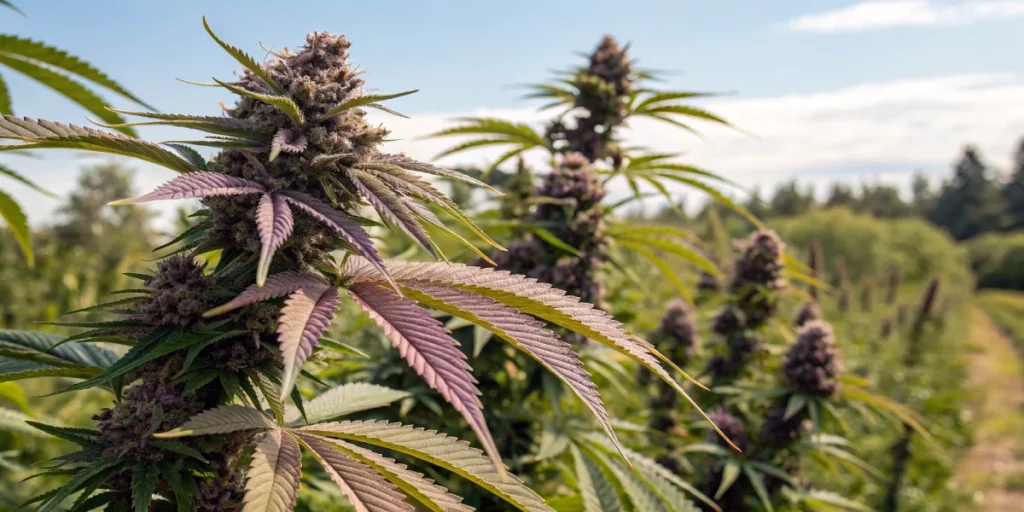
Benefits and Perceptions of Purple Cannabis
Potency, Flavor, and Aroma Characteristics
Purple cannabis often raises questions about its potency, flavor, and aroma. Many believe that the pigmentation might affect these qualities, yet research shows that the purple color does not necessarily change the chemical composition of the plant. Instead, it offers a unique sensory profile that distinguishes it from green strains. The question of why is some weed purple often comes up in discussions about how these plants may taste or smell slightly different from standard varieties.
Consumers appreciate the distinct characteristics of purple cannabis, which can include subtle fruity or berry-like notes. These differences may add to its market appeal without affecting the overall potency. The sensory attributes are a result of the plant’s complex chemistry, providing an extra layer of interest that makes growers and users alike ask, why is some weed purple in a way that enhances its uniqueness without compromising quality.
Market Appeal and Consumer Interest
The market appeal of purple cannabis is high, and many consumers are drawn to its unique appearance. Retailers often notice increased interest in purple strains, prompting discussions on why is some weed purple. The vibrant coloration can set these products apart on the shelf, attracting buyers who seek both visual novelty and quality. This consumer interest fuels further research and selective breeding for purple traits, as the aesthetic appeal has a direct impact on sales and reputation.
Retailers and growers alike benefit from the popularity of purple cannabis. Its unique look creates a memorable impression that helps build brand identity in a competitive market. The combination of visual appeal and consistent quality makes it easy to see why is some weed purple captivates the attention of both novices and connoisseurs, making it a valuable asset in any cannabis business.
Myths and Scientific Insights on Purple Weed
Debunking Common Misconceptions
There are many myths about purple cannabis, and one common misconception is that the color change indicates poor quality or low potency. In reality, the purple hue is a natural occurrence linked to anthocyanin production. When you ask why is some weed purple, the answer lies in the plant’s biology and genetic makeup rather than any inherent flaw. Misunderstandings persist, but science shows that purple cannabis can be just as potent as its green counterparts.
These misconceptions often arise from misinformation and lack of scientific evidence. By looking at research and real-world cultivation results, it becomes clear that color is not an indicator of quality. Instead, the purple appearance adds to the plant’s charm and appeal. Clearing up these myths helps everyone understand why is some weed purple is simply a natural variation that many growers actively seek.
The Science Behind Cannabis Color Variations: Why is some weed purple?
Scientific studies reveal that color variations in cannabis are primarily due to the synthesis of anthocyanins. These pigments are produced in response to environmental stressors such as cold temperatures and specific light exposure. This phenomenon answers the persistent question of why is some weed purple by linking it to a chemical process that is both natural and beneficial. The science shows that pigment production is a normal response that does not compromise the plant’s health or potency.
Researchers continue to study how different growing conditions affect pigment levels, providing deeper insights into cannabis biology. The research reinforces that color change is not a defect but an adaptation. As more data becomes available, the question of why is some weed purple becomes easier to answer with facts that support both aesthetic and functional benefits in cannabis cultivation.
Popular Purple Strains
Purple Haze
Purple Haze is a striking strain known for its vibrant purple tones and energetic effects. Its deep coloration comes from a natural increase in anthocyanins, which makes it stand out among many cannabis varieties. This strain is popular with growers looking for a visually appealing plant that performs well in a variety of conditions. Its resilience under fluctuating temperatures makes it a favorite for those curious about why is some weed purple in a natural setting.
Purple Haze offers a balanced blend of uplifting and mellow effects that many find enjoyable. Its flavor profile hints at berry and spice notes, adding to its overall appeal. Growers appreciate its low-maintenance characteristics and predictable flowering cycle. The visual and sensory attributes of Purple Haze continue to capture the interest of both seasoned and new cultivators alike, making it one of the most celebrated purple strains in the cannabis community.
Purple Kush
Purple Kush is renowned for its deep purple hues and relaxing effects. This strain develops its distinctive color as the temperature drops, prompting the production of anthocyanins. Its robust nature and consistent performance under varying environmental conditions have made it a staple for many growers. Observing Purple Kush in bloom often leads to questions like why is some weed purple, as its rich pigmentation is both natural and captivating.
In addition to its visual appeal, Purple Kush delivers a potent, soothing effect that is ideal for unwinding after a long day. Its earthy flavor profile, with subtle hints of grape and citrus, makes it a favorite among users seeking a smooth, calming experience. Cultivators enjoy its hardy growth characteristics, which allow it to thrive in both indoor and outdoor setups. The strain’s ease of growth and distinct appearance ensure that it remains popular in many cannabis gardens.
Granddaddy Purple
Granddaddy Purple, often called GDP, is famous for its intense purple color and powerful relaxing effects. This strain’s deep violet hue is a result of a natural genetic predisposition to produce high levels of anthocyanins under the right environmental conditions. Its striking appearance frequently sparks the question why is some weed purple, as the color variation is a hallmark of its unique genetic makeup and growth conditions.
Granddaddy Purple is well-loved for its rich, sweet flavor with hints of grape and berry. Its effects are deeply relaxing, making it a go-to choice for those seeking stress relief and a calm mind. The strain’s adaptability to various growing conditions makes it accessible for many cultivators. With its impressive visual appeal and consistent performance, Granddaddy Purple continues to be a top pick for those looking to add a touch of color and relaxation to their cannabis garden.
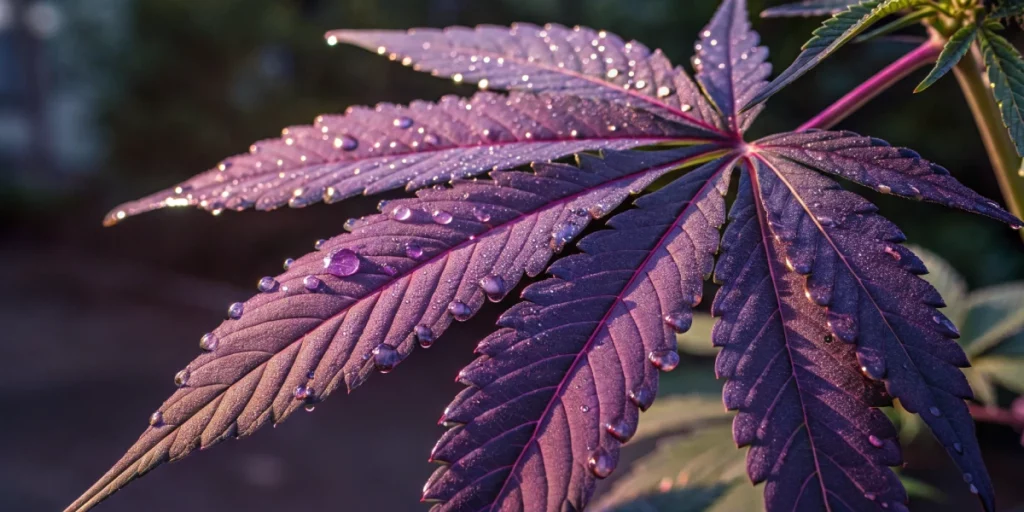
FAQs about why is some weed purple
What causes weed to turn purple?
The purple color in weed is caused by anthocyanins, natural pigments that form when plants are exposed to cooler temperatures and specific light conditions. These pigments blend with chlorophyll, creating a striking purple hue. Genetic factors also contribute, as some strains are predisposed to develop more pigment. This scientific process explains why is some weed purple under ideal environmental conditions, ensuring vibrant, appealing colors truly.
Does purple weed affect potency?
Purple weed does not affect the potency of the cannabis. The color change is due to pigment production and does not alter the levels of cannabinoids like THC or CBD. Many purple strains are just as strong as their green counterparts, offering similar effects and benefits. The unique coloration may even add to their appeal without compromising quality or medicinal properties in any significant way.
Can growing conditions affect why is some weed purple?
Growing conditions can have a significant impact on why is some weed purple. Factors such as temperature, light exposure, and soil composition influence pigment production in cannabis plants. Cooler nights and variable light often trigger the formation of anthocyanins, resulting in a purple hue. By adjusting these conditions, growers can enhance the purple coloration without compromising plant health, leading to crops that meet consumer preferences.

